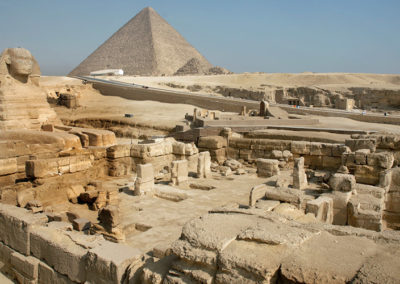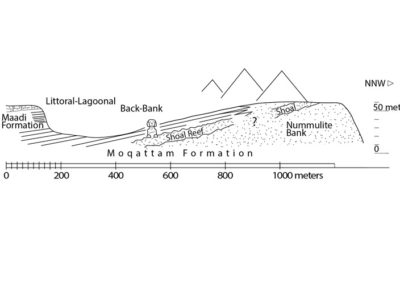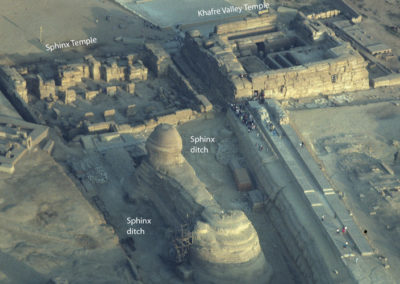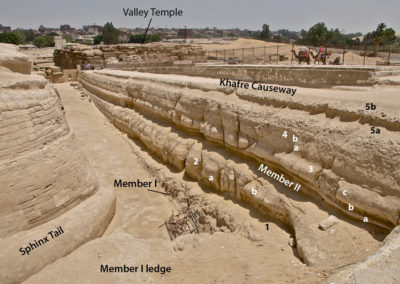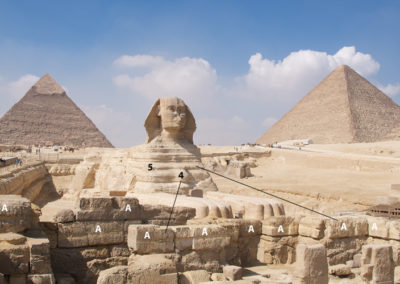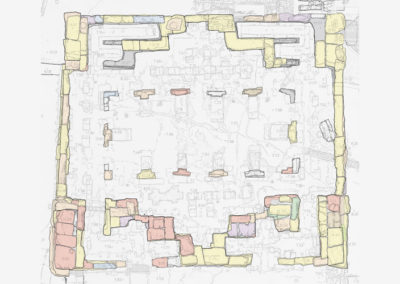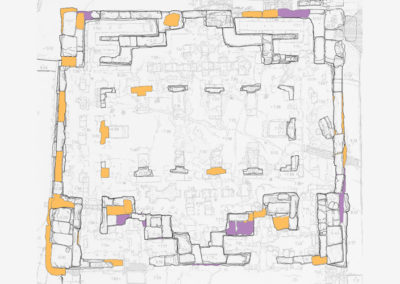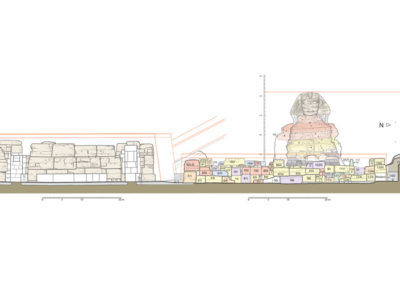Who Built the Sphinx?
Who Built the Sphinx? The Sphinx Temple Has the Answer
by Mark Lehner
Who built the Sphinx? One Egyptologist claims it was Khufu, builder of the Great Pyramid.1 Others say it was Khafre, builder of the second pyramid.2 Some geologists believe the Sphinx could be older.3 About half a dozen scholars are debating the question.
Many alternative thinkers claim the Sphinx is much, much older, that it existed thousands of years before Khufu. But our study of the Sphinx and the temple lying just below it—the Sphinx Temple—says no. As certain as we can be about such matters, Khafre created most of the Sphinx. However, Khufu might have started it.
Stone by Stone
Between 1979 and 1983, I mapped, stone by stone, the Sphinx, the Sphinx Temple, and the adjacent Khafre Valley Temple.
Starting in 1980, geologist Tom Aigner joined me.
The stone-by-stone map of the Sphinx Temple allowed us to investigate a telltale clue about who built the Sphinx. Quarrymen cut the core blocks (the ones forming the core of the temple walls) so thick—some weigh up to a hundred tons—that many of them include three geological layers. And it was clear that the layers in many blocks were the same as those that run through the bedrock of the Sphinx itself. The blocks had to have come from the U-shaped ditch around the Sphinx. When workers quarried the ditch they left a large block of limestone from which the Sphinx was carved.
As I moved about the Sphinx Temple during my first year of the mapping project, I was struck by how the geological layers run continuously in many places, from one block to another, as the layers must have run in the bedrock. The gangs of young men who moved these mighty stones did not have much chance of mixing them up from quarry to temple wall. The Sphinx and its temple must have been part of the same quarry-construction sequence. But could I prove this?
Fingerprinting the Core Blocks
The following year I met Tom, who had the expertise needed to geologically “fingerprint” the blocks and trace them back to the quarry. Tom looked at the Giza Plateau less as an archaeological site and more as frozen sea floors, petrified, pancaked, and stacked into the bedrock layers from which the pyramid builders quarried blocks, created tombs, and carved the Sphinx.
These layers formed during the Eocene epoch—some 34 to 56 million years ago, as a great primordial sea retreated northward. Under its ebbing waters, a colossal bank of nummulites, unicellular plankton-like organisms, built up. A sandbar developed on the embankment, and in the more protected waters behind it, a shoal and coral reef grew. As the sea retreated to the north, the area behind the sand bank became a muddy lagoon, inhabited by burrowing bivalves and sea urchins. A regular sequence accumulated, which petrified as soft, yellow, marly layers interspersed with harder beds.
In carving the Sphinx directly from the natural rock, the ancient Egyptian quarrymen cut a cross-section through the principal geological layers of the southeastern slope of the Moqattam Formation (see Figure 4). The hard layers of the shoal and reef, for example, make up the lowest layer (Member I, see Figures 10-11) in the Sphinx and its ditch. The shallow waters of the lagoon laid down sediments that make up the layers running through the body of the Sphinx (Member II, see Figures 10-11). Turbulent waters churned up mud and silts, which petrified into softer layers. Calmer waters laid down more compact sedimentation, the harder layers. The Sphinx head is of harder bedrock (Member III, see Figures 10-11) than the body, representing, again, calmer waters.
Mapping
Tom and I began our Sphinx Temple core block study by examining each layer, or bed, of the Sphinx. (At that time, more of the Sphinx’s bedrock core was visible than today.) We gave each bed a number and marked them on photographs and on profiles of the Sphinx. The beds were easy to distinguish as they weathered differentially: harder beds protruded, softer beds receded. Also, the relative abundance of different fossils varied. Members I and II showed the greatest differences: I is a very hard gray reef formation, while the first bed of Member II, 2b, is one of the softest of the yellow marl-clay layers. Members II and III are distinct, but the boundary is not so clear as between I and II. Aigner, following an earlier geologist, set the boundary between Beds 7 and 8.
The massive fine-grained bedrock of Beds 8–9 (Member III) made for good sculpting, with far more endurance than the soft-hard-soft sequence of Member II. This is why the 4th Dynasty builders reserved Member III for the more exposed head. Details like the eyebrows have survived wind, rain, and sand for 4,500 years. But the Member II sequence was perfect for quarrying giant core blocks, because quarrymen could cut the bottoms and tops of the blocks along the clay-like yellow beds, and take out as many intervening beds as required (generally three) for the thickness of the block.
But from which beds exactly did they cut the core blocks? Would this tell us where they were in fashioning the Sphinx at the time they built the Sphinx Temple? To answer these questions we logged each block. We recorded their lithic qualities and fossil content, and assigned each block to one of seven types, A through G.
What the Core Block Types Tell Us
Most of the Sphinx Temple core blocks are Type A (yellow on Figures 10-12) and consist of three layers: upper and lower hard massive layers separated by the soft, yellow marl layer in the middle, which runs continuously through separate blocks over long stretches of temple wall (as seen in Figure 3). These blocks come from beds that correspond to the lower chest of the Sphinx.
Type C blocks (red, see Figures 10-12) come from beds that correspond to the Sphinx’s upper chest, top of the chest, and base of the neck. In the Sphinx Temple these blocks cluster near the front. The quarry workers hewed the blocks from layers that would become the lion’s upper chest and top of the back and then dragged them to the eastern front of the Sphinx Temple. As quarry workers cut deeper, to the middle and lower Sphinx chest level, haulers and builders composed most of the core walls of the temple.
Block types B and D did not come from the Sphinx ditch. They most closely match strata to the southwest, exposed in the quarry cut for the Khentkawes Monument. They are less frequent and more intermittent in the temple walls than the A and C blocks. This could indicate that the builders stockpiled these blocks and brought them into the walls whenever there was a hiatus in the quarrying, dragging, and placing of the A blocks from the Sphinx ditch. The scanty distribution of B and D blocks might also reflect the fact that because they had to be hauled so far, it took much longer to deliver them to the temple than it took to drag A blocks from the Sphinx ditch.
Type G Blocks and the Temple Sequence
Type G blocks were not used in the Sphinx Temple, except for three instances, but they form the bulk of the Khafre Valley Temple. Aigner observed that this type of limestone cannot be found in the immediate Sphinx area, but seems to derive from strata which are equivalent to the Sphinx’s head. I would suggest that they were not only equivalent to the Sphinx head, but actually came from it.
I hypothesize that as quarrymen worked down through the Member III strata (Sphinx head), they took the blocks to the southeast to make the core walls of the Khafre Valley Temple on the southern half of a terrace they had already leveled. They removed the Member III layers from all around the Sphinx head, leaving an island of Member III beds.
They continued quarrying down through the bedrock strata, removing Member II layers, carving out the Sphinx ditch, while reserving the block for the Sphinx body. They cut the C blocks from the upper beds of Member II and hauled them to the east side of the Sphinx Temple site. Then they worked their way down into the lower layers of Member II, cutting the A blocks, which they dragged to the temple site and used to create the Sphinx Temple walls.
This hypothetical construction sequence fits the general pattern of G blocks (beige, head) in the Khafre Valley Temple, C blocks (red, upper chest and neck) mostly in the eastern walls of the Sphinx Temple, and A blocks (yellow, lower chest) comprising most of the Sphinx Temple (see Figure 12).
Unfinished Projects
Khafre’s workers started shaping the Sphinx as they built his valley temple. And they were probably still shaping the lower lion body, cutting it out of its surrounding ditch, as they made the Sphinx Temple, Khafre’s last major addition to his pyramid complex. But they did not finish. They left the Sphinx Temple incomplete, without its exterior granite casing. Quarrymen never finished completely cutting and straightening the Sphinx ditch, leaving a huge massif of Member I bedrock projecting to within a meter of the tail.
Did the Sphinx Originate with Khufu?
The connections between Khufu and the Sphinx are intriguing, but tenuous. Just to the north of the Sphinx, a quarry cut lies at the end of Giza’s central canal basin4 and could have created a hauling track from the delivery basin to Khufu’s pyramid. That cut forms the North Cliff of the Sphinx ditch. Perhaps Khufu, or his courtiers, first conceived the Sphinx and started quarrying to create it.
Certain associations have come to light in recent years between Khufu and the lion. A reference to “lion” is prominent in one of the names of work gangs that Pierre Tallet and team found in Khufu’s port at Wadi el-Jarf5. They found the names inscribed in ink on water jars, anchors, large stone blocks that plugged the rock-cut galleries, and in account papyri. Tallet writes that the name refers to a metaphorical mixing of king and lion. Should Khufu have used the same metaphorical mixing to conceive the Sphinx, then Khufu would not only have built the Great Giza Pyramid, he would also be the one who formulated the Great Giza Lion, the Sphinx, which certainly manifests king as lion. East elevation of the Khafre Valley Temple (after U. Hölscher, Das Grabdenkmal des Königs Chephren, Leipzig: J. C. Hinrichs’sche, 1912), Sphinx Temple (after H. Ricke, “Der Harmachistempel des Chefren in Giseh,” Beiträge zur ägyptischen Bauforschung und Altertumskunde 10, plate 2, 1970), and the Sphinx (from Ulrich Kapp’s photogrammetry), with core blocks and bedrock strata. Khafre Valley Temple core blocks are hypothesized to be Type G and to derive from Sphinx head layers.
At Saqqara a Japanese mission found four terracotta statues of a lion goddess and two terracotta recumbent lion statues in subterranean chambers under the so-called “Lion Hill,” a monument of many periods.6 One of the recumbent lions bears the inscription “King of Upper and Lower Egypt, Khufu” (nswbity 2wfw) between the paws. Khufu’s Horus name (1r MDdw) is added to the side of the back pillar of one of the standing statues, which features at the feet of the goddess small figures of kings Khufu and Pepi I. It is possible this entire set of lion statues was made originally for Khufu.
None of this is entirely convincing that Khufu started the Sphinx, but it is worth considering. The evidence linking Khafre and the Sphinx is stronger, although not absolute “proof.” However, the stratified building sequence of the Khafre Valley Temple and Sphinx Temple makes it highly probable that Khafre built both temples, while leaving the Sphinx Temple unfinished.7
Figure 1: The Sphinx stares resolutely ahead, oblivious of Mark Lehner (right) and Richard Redding, investigating the Sphinx’s geological layers. Photo by Charlotte Keyte.
Figure 3: Core blocks (Type A) on the western side of the Sphinx Temple, cut from three geological layers, with a thin marl layer—the “yellow band”—running continuously through the middle of three blocks.
Figure 4: Schematic profile by Tom Aigner shows the principal geological layers of the Moqattam (Middle Eocene) and Maadi (Upper Eocene) Formations that make up the Giza Plateau. After T. Aigner, “Zur Geologie und Geoarchaologie des Pyramidenplateaus von Giza,” Natur und Museum 112, pages 377–388, figure 4, 1982.
Figure 5: The Sphinx in its ditch, fronted by the Sphinx Temple and Khafre Valley Temple. When the ancient workers quarried the ditch they left a large block of limestone from which the Sphinx was carved.
Figure 6: Lagoon layers, of Member II, in the south side of the Sphinx ditch (which forms the northern side of Khafre’s causeway, connecting his valley temple and upper pyramid temple), with numbered beds of Members I and II. According to Aigner’s model (see Figure 4), these layers derive from a back-bay lagoon along what became the southeastern flank of the plateau, behind the nummulite embankment and coral reef, as the Eocene sea water retreated northward about 50 million years ago. View to the southeast.
Figure 7: Sphinx and Sphinx Temple core blocks (foreground). Type A blocks (labeled) derive from Beds 4 and 5; see Figures 10 and 11.
Figure 8: Sphinx Temple core blocks color-coded for block type. Most core blocks are Type A, yellow, which matches Beds 4b–c to 5b in the Sphinx’s lower chest. Type C blocks, red, match Beds 7b–8a in the upper chest and top of the back of the Sphinx and cluster to the front of the temple.
Figure 9: Distribution of Type B and D core blocks (orange and purple) within the Sphinx Temple. These did not come from the Sphinx ditch.
Figure 10: Profile across the front of the Sphinx and across the Sphinx ditch, with limestone beds numbered. Color codes indicate source layers of large limestone core blocks in the Sphinx Temple.
Figure 11: North elevation of the Sphinx, produced with photogrammetry by Ulrich Kapp, with limestone bedrock beds indicated and labeled by Mark Lehner. The Sphinx faces east. Colors signify match of beds (layers) to core blocks in the Sphinx Temple and Khafre Valley Temple.
Figure 12: East elevation of the Khafre Valley Temple (after U. Hölscher, Das Grabdenkmal des Königs Chephren, Leipzig: J. C. Hinrichs’sche, 1912), Sphinx Temple (after H. Ricke, “Der Harmachistempel des Chefren in Giseh,” Beiträge zur ägyptischen Bauforschung und Altertumskunde 10, plate 2, 1970), and the Sphinx (from Ulrich Kapp’s photogrammetry), with core blocks and bedrock strata. Khafre Valley Temple core blocks are hypothesized to be Type G and to derive from Sphinx head layers.
1. Stadelmann, R., “The Great Sphinx of Giza,” in Egyptology at the Dawn of the Twenty-first Century: Proceedings of the Eighth International Congress of Egyptologists, Cairo, 2000, edited by Z. Hawass and L. P. Brock, Cairo: The American University in Cairo Press, pages 464–469, 2000.
2. Reisner, G. A., A History of the Giza Necropolis, Cambridge: Harvard University Press, 1942.
3. Schoch, R., “Re–dating the Sphinx,” KMT 3 (2), pages 53–67, 1992. Reader, C. D., “A Geomorphological Study of the Giza Necropolis, with Implications for the Development of the Site,” Archaeometry 43 (1), pages 149–159, 2001.
4. I reconstructed that waterway based on evidence; see M. Lehner, “On the Waterfront: Canals and Harbors in the Time of Giza Pyramid-building,” AERAGRAM 15 (1&2), pages 14–23, 2014.
5. Tallet, P., “Des serpents et des lions et des lions: La flotte stupéfiante de Chéops en Mer Rouge,” in Du Sinaï au Soudan, Itinéraires d’une égyptologue (Mélanges offerts à Dominique Valbelle), edited by N. Favry, C. Ragazzoli, C. Somaglino, and P. Tallet, Paris: Editions de Boccard, pages 247 and 249–251, 2017.
6. Yoshimura, S., N. Kawai, and H. Kashiwagi, “A Sacred Hillside at Northwest Saqqara. A Preliminary Report on the Excavations 2001–2003,” Mitteilungen des Deutschen Archäologischen Instituts, Abteilung Kairo 61, pages 390–394, figures 21–22, 2005.
7. For more information see M. Lehner, “Unfinished Business: The Great Sphinx. Why it is most probable that Khafre created the Sphinx,” AERAGRAM vol 5 no 2, pages 10-15.


